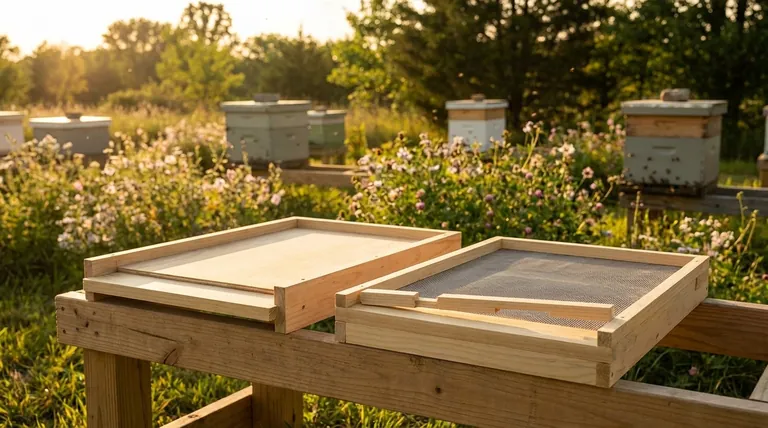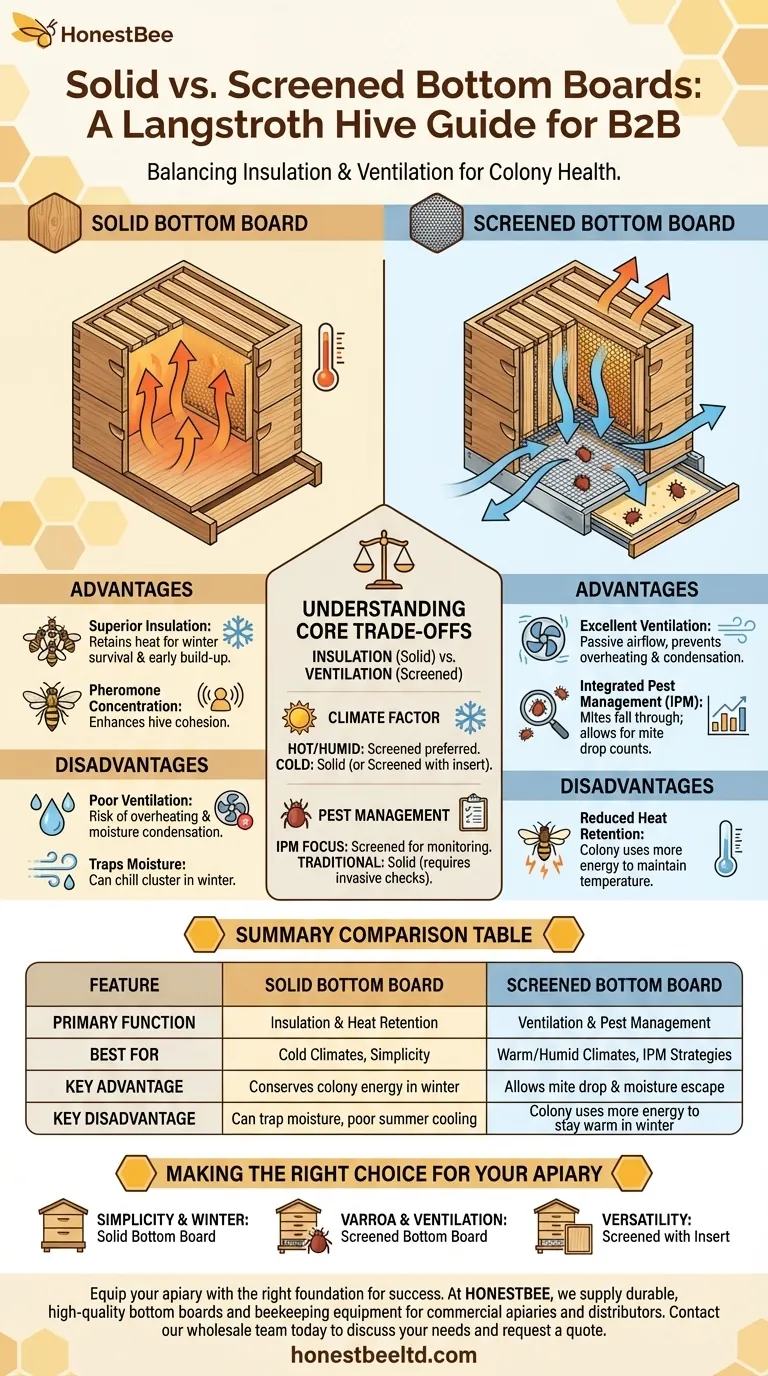The fundamental difference between solid and screened bottom boards lies in a trade-off between insulation and ventilation. A solid bottom board retains heat and conserves the colony's energy, while a screened bottom board provides superior air circulation and an integrated tool for pest management.
Your choice of bottom board is not a permanent commitment but a strategic decision based on your local climate, your pest management philosophy, and the changing needs of your colony throughout the year.

The Role of the Solid Bottom Board
A solid bottom board is the traditional, simple floor for a Langstroth hive. It is a single, solid piece of wood that completely closes off the bottom of the hive from the outside environment.
Advantage: Superior Insulation
In colder climates, a solid board is highly effective at retaining the heat generated by the bee cluster.
This conservation of energy can be critical for winter survival and may encourage the queen to begin laying eggs earlier in the spring, leading to a faster colony build-up.
Advantage: Pheromone Concentration
By creating a closed environment, a solid board helps contain the queen's pheromones within the hive. This can enhance hive cohesion and communication among the bees.
Disadvantage: Poor Ventilation
The primary drawback is a lack of airflow. In hot summers, this can cause the colony to overheat, forcing bees to expend energy fanning at the entrance instead of foraging. In winter, it can trap moisture, leading to condensation that drips on the cluster and chills the bees.
The Role of the Screened Bottom Board
Also known as an Integrated Pest Management (IPM) board, a screened bottom board replaces the solid wood floor with a durable wire screen.
Advantage: Excellent Ventilation
The screen provides continuous, passive ventilation. This helps cool the hive during hot weather and allows excess moisture to escape during the winter, preventing harmful condensation buildup.
Advantage: Integrated Pest Management
This is the most significant advantage. Varroa mites, a major honey bee parasite, will occasionally fall off their bee hosts. With a screened bottom, many of these mites fall completely out of the hive, unable to climb back up.
Beekeepers can also place a "sticky board" or drawer underneath the screen to perform a mite drop count, an essential method for monitoring infestation levels without disturbing the colony.
Disadvantage: Reduced Heat Retention
The same ventilation that benefits the hive in summer can be a liability in deep winter. The colony must work harder and consume more honey stores to maintain its cluster temperature, which can be a challenge in harsh northern climates.
Understanding the Core Trade-offs
Neither bottom board is universally "better." The optimal choice depends entirely on your specific conditions and beekeeping goals.
Climate is a Major Factor
In hot, humid regions, the superior ventilation of a screened board is almost always the better choice to prevent overheating.
In regions with severe winters, a solid board provides crucial insulation. However, many beekeepers in cold climates still successfully use screened boards, often by inserting a solid panel or "Varroa drawer" during the coldest months.
Your Pest Management Strategy
If you practice IPM, a screened bottom board is an invaluable diagnostic tool. It allows you to monitor mite levels passively and make informed decisions about when treatment is necessary.
With a solid board, monitoring for mites typically requires more invasive methods like a sugar roll or alcohol wash.
Making the Right Choice for Your Apiary
Your decision should be a conscious one based on the needs of your bees and your management style.
- If your primary focus is simplicity and winter survival in a cold climate: A solid bottom board is a reliable and straightforward choice.
- If your primary focus is managing Varroa mites and hive ventilation in a warm climate: A screened bottom board provides essential airflow and pest management capabilities.
- If you want a versatile, year-round solution: A screened bottom board with a removable insert drawer offers the benefits of both systems.
By understanding these principles, you can provide the right foundation for a healthy and thriving colony.
Summary Table:
| Feature | Solid Bottom Board | Screened Bottom Board |
|---|---|---|
| Primary Function | Insulation & Heat Retention | Ventilation & Pest Management |
| Best For | Cold Climates, Simplicity | Warm/Humid Climates, IPM Strategies |
| Key Advantage | Conserves colony energy in winter | Allows mite drop & moisture escape |
| Key Disadvantage | Can trap moisture, poor summer cooling | Colony uses more energy to stay warm in winter |
Equip your apiary with the right foundation for success.
Whether you manage a few hives or a large commercial operation, the choice between solid and screened bottom boards is critical for colony health and honey production. At HONESTBEE, we supply durable, high-quality bottom boards and a full range of beekeeping equipment designed for the demands of commercial apiaries and distributors.
Let our expertise help you make the best decision for your specific climate and management goals. Contact our wholesale team today to discuss your needs and request a quote.
Visual Guide

Related Products
- Langstroth Screen Bottom Board for Beekeeping Wholesale
- Australian Pine Wood Langstroth Screen Bottom Board for Wholesale
- Professional Drop-Style Hive Handles for Beekeeping
- Professional Galvanized Hive Strap with Secure Locking Buckle for Beekeeping
- HONESTBEE Durable Frame Wiring Board with Integrated Tensioner
People Also Ask
- How should the screened bottom board be used throughout the year? A Guide for Healthy Hives
- What are some considerations when choosing between solid and screened bottom boards? Optimize Hive Health & Pest Control
- What are the main benefits of using a Screened Bottom Board in beekeeping? Enhance Hive Health & Productivity
- What are the advantages of a screened bottom board? Boost Hive Health with Superior Ventilation & Pest Control
- What are the benefits of a screened bottom board? Boost Hive Health & Control Varroa Mites



















